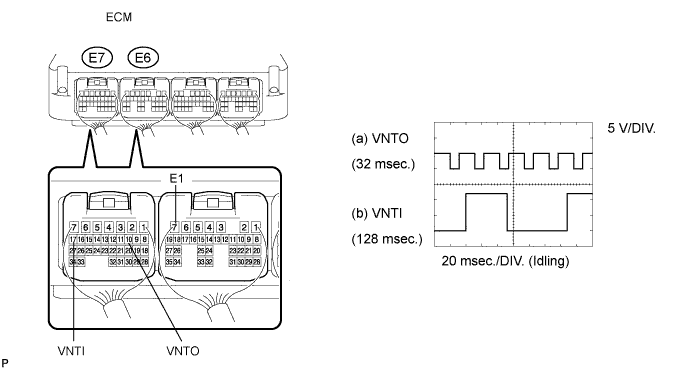Intake Air Control System -- On-Vehicle Inspection |
| 1. CHECK INTAKE MANIFOLD |
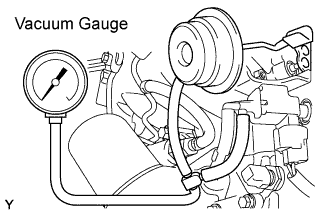 |
Connect a vacuum gauge between the control valve and VSV.
Warm up the engine.
Measure the vacuum.
- Standard vacuum:
Engine Condition VSV Condition Specified Condition Normal engine speed ON Approx. 35 kPa (263 mmHg, 10.35 in.Hg) 3,000 rpm or more OFF 0 kPa (0 mmHg, 0 in.Hg)
| 2. CHECK INTAKE AIR SYSTEM |
Check for leakage or clogging between the air cleaner housing and turbocharger inlet, and between the turbocharger outlet and cylinder head.
Condition Operation Clogged air cleaner Clean or replace Collapsed or deformed hoses Repair or replace Leakage from connections Check each connection and repair Cracks in components Check and replace
| 3. CHECK EXHAUST SYSTEM |
Check for leakage or clogging between the cylinder head and turbocharger inlet, and between the turbocharger outlet and exhaust pipe.
Condition Operation Deformed components Repair or replace Foreign matter in passages Remove Leakage from components Repair or replace Cracks in components Check and replace
| 4. CHECK BOOST PRESSURE |
Warm up the engine.
- HINT:
- Be sure to perform the inspection when the engine coolant temperature is between 75 and 90°C (167 and 194°F).
Using a 3-way connector, connect SST (turbocharger pressure gauge) to the hose between the manifold absolute pressure sensor and the gas filter leading to the intake air connector.
- SST
- 09992-00242
 |
Fully apply the parking brake and chock the 4 wheels.
for Manual Transmission:
While depressing the clutch pedal, fully depress the accelerator pedal. Measure the boost pressure at maximum engine speed (approximately 4600 rpm).- Standard pressure (Gauge pressure):
- 15 to 45 kPa (0.15 to 0.46 kgf/cm2, 2.1 to 6.5 psi)
for Automatic Transmission:
Move the shift lever to P or N, and then fully depress the accelerator pedal. Measure the boost pressure at maximum engine speed (approximately 4600 rpm).- Standard pressure (Gauge pressure):
- 15 to 45 kPa (0.15 to 0.46 kgf/cm2, 2.1 to 6.5 psi)
- The intake system or exhaust system has leakage or blockage.
- The turbocharger sub-assembly or turbo motor driver is malfunctioning.
- The EGR valve does not close.
- The diesel throttle body does not open.
- The vacuum hose connected to the diesel turbo pressure sensor (manifold absolute pressure sensor) is cracked or disconnected.
- The mass air flow meter is malfunctioning.
- A fuel injector is malfunctioning.
Chart showing the suspected trouble areas when the pressure is lower than the standard.
- HINT:
- ○: If a problem listed in the leftmost column of the chart exists, or if the part in the leftmost column of the chart has a malfunction, the value of the Data List item in the uppermost row of the chart will meet the conditions shown in the row labeled "Value which represents a malfunction".
- The values in the chart are applicable when the engine coolant temperature is between 75 and 90°C (167 and 194°F).
- The values in the chart are for vehicles equipped with a manual transmission. For vehicles with an automatic transmission, use these values as a reference only as they may differ from the actual values.
- The values in the chart are valid in an area with an absolute atmospheric pressure higher than 95 kPa. (Standard atmospheric pressure is 101 kPa. Atmospheric pressure decreases by 1 kPa for every 100 m increase in altitude, and is also affected by the current weather conditions.)
- When the altitude increases, atmospheric pressure and MAP decrease.
Item MAP
(Absolute pressure inside intake manifold)MAF
(Intake air flow rate)Accel Position Actual Throttle Position Actual EGR Valve Position EGR Close Lrn. Status
(EGR valve fully closed position learning status)Fuel Pressure Injection Feedback Val #1 (to #4) Values taken from an actual normal vehicle
*1- 128 g/sec. 99% or more None None None - -3 to +3 mm3/st Values which represent a malfunction
*1None MAF is less than 115 g/sec. Accel Position is not fully depressed position
*2None None
*3None
*3Fuel Pressure is lower than Target Common Rail Pressure by 10 MPa or more
(Check while steady condition)Outside of above range Turbocharger ○ ○ - - - - - - EGR valve does not close or has problem with movement ○ ○ - - ○
(Problem with EGR valve movement)
*4○
(EGR valve does not close)
*4- - Problem with diesel throttle movement ○
(Intake airflow decreases)○ - ○ - - - - Accelerator pedal cannot be fully depressed or problem with accelerator pedal position sensor exists - ○ ○ - - - - - Intake air system leakage or blockage ○ ○ - - - - - - Exhaust gas leakage before turbocharger or blockage ○ ○ - - - - - - Manifold absolute pressure sensor ○ ○ - - - - - - Manifold absolute pressure sensor hose is disconnected ○ ○ - - - - - - Mass air flow meter sub-assembly - ○ - - - - - - Fuel system (injector, supply pump or common rail) ○ ○ - - - - ○
(Fuel injector leakage, decrease in pressure discharge valve relief pressure or valve is stuck)○
*5- HINT:
- *1: These values are measured when the transmission is in 2nd gear, the accelerator pedal is fully depressed, the vehicle is accelerating, and the engine speed is 3000 rpm.
- *2: The Accel Position is the accelerator opening angle (%) for engine control use. The value indicates around 100 % when the accelerator pedal fully depressed. If the value does not indicate around 100 % when the accelerator pedal fully depressed, the accelerator pedal position sensor circuit or the pedal itself is malfunctioning. When the MIL is illuminated, even with the accelerator pedal fully depressed and an Accel Position of below 70%, it means the fail-safe is restricting the accelerator.
- *3: The Data List items indicated on the tester differ according to vehicle model and engine type. If the Data List items Actual EGR Valve Pos. and EGR Lift Sensor Volt % are not available, troubleshoot the EGR valve malfunction by reading the MAF value in the Data List items. If the MAF value is lower than normal engine conditions, the EGR valve can be assumed to be malfunctioning (the valve cannot close fully). In this case, perform the Activate the VSV for EGR Cut (or Control the EGR System) in the Active Test function while the engine is idling, and check that the MAF value fluctuates according to the Active Test operation. Inspect the EGR valve for any defects (deposits, valve stuck, poor movement, etc.) if necessary.
- *4: If the actual EGR valve position follows the target EGR valve position slowly, a feeling of hesitation may occur.
- *5: If Injection Feedback Val # of a cylinder is not within -3 to +3 mm3/st, the corresponding cylinder may have a malfunction (injector or compression). However, in some cases the cylinder may be malfunctioning even if the value is within -3 to +3 mm3/st because these values are injection volume correction values calculated by the ECM at the engine idling and not correction values for the high engine load condition related to the boost pressure control and engine output performance.
| 5. CHECK MANIFOLD ABSOLUTE PRESSURE SENSOR |
Inspect the power source voltage.
Disconnect the pressure sensor connector.
Turn the ignition switch ON.
Measure the voltage between terminals T9-3 (VC) and T9-1 (E) of the wire harness side connector.
- Standard voltage:
- 4.75 to 5.25 V
Turn the ignition switch OFF.
Connect the pressure sensor connector.
 |
Check the power supply.
Turn the ignition switch ON.
Disconnect the vacuum hose from the pressure sensor.
Connect a voltmeter to terminals E6-28 (PIM (+)) and E7-28 (E2 (-)) of the ECM, and measure the output voltage at ambient atmospheric pressure.
Apply a vacuum to the pressure sensor in 13.3 kPa (100 mmHg, 3.94 in.Hg) increments until the pressure reaches 40.0 kPa (300 mmHg, 11.81 in.Hg). Measure the decrease in voltage for each increment.
- Standard voltage:
Applied Vacuum Voltage Decrease -13.3 kPa (100 mmHg, 3.94 in.Hg) 0.1 to 0.4 V -26.6 kPa (199 mmHg, 7.85 in.Hg) 0.2 to 0.6 V -40 kPa (300 mmHg, 11.81 in.Hg) 0.4 to 0.8 V
Using SST (turbocharger pressure gauge), apply pressure to the pressure sensor in 19.6 kPa (0.20 kgf/cm2, 2.84 psi) increments until the pressure reaches 98.0 kPa (1.00 kgf/cm2, 14.2 psi). Measure the increase in voltage for each increment.
- SST
- 09992-00242
- Standard voltage:
Applied Pressure Voltage Decrease 19.6 kPa (0.20 kgf/cm2, 2.84 psi) 0.1 to 0.4 V 39.2 kPa (0.40 kgf/cm2, 5.69 psi) 0.4 to 0.7 V 58.8 kPa (0.60 kgf/cm2, 8.53 psi) 0.7 to 1.0 V 78.5 kPa (0.80 kgf/cm2, 11.4 psi) 1.0 to 1.3 V 98.0 kPa (1.00 kgf/cm2, 14.2 psi) 1.3 to 1.6 V
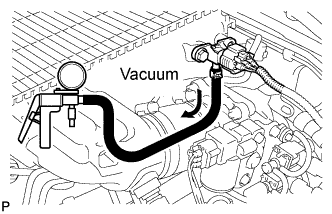
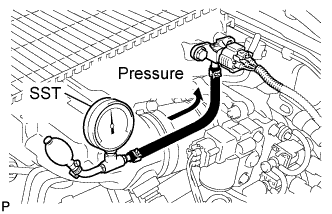
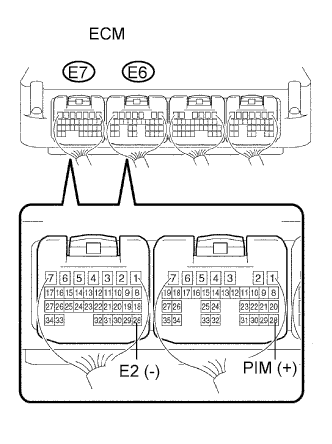 |
| 6. CHECK TURBOCHARGER SUB-ASSEMBLY (ACTUATOR OPERATION) |
- CAUTION:
- Wear protective gloves to prevent injuries and burns when checking the turbocharger.
- The engine compartment becomes hot when the engine is running.
Remove the No. 1 exhaust manifold heat insulator (Toyota Fortuner RM00000143U002X_01_0011.html) and No. 1 turbo insulator (Toyota Fortuner RM00000143U002X_01_0012.html).
Check the stroke.
- NOTICE:
- Make sure the DC motor's connectors are properly installed.
Turn the ignition switch ON and OFF.
Check the DC motor's operation. Check that the motor rod stroke is as shown in A to D in the illustration below.
After the DC motor operates, visually check that the vane activation link contacts the fully closed stopper.
- NOTICE:
- Never loosen or tighten the fully closed stopper's lock nut.

If the result is not as specified, check the ECM (Toyota Fortuner RM0000013FU02WX.html) and turbo motor driver (Toyota Fortuner RM000002PPM01WX.html).
| 7. CHECK TURBO MOTOR DRIVER |
 |
Check the voltage of the turbo motor driver.
Turn the ignition switch ON.
Measure the voltage of the motor driver.
- Standard voltage:
Tester Connection Specified Condition T34-3 (+B) - Body ground 9 to 14 V
Check the resistance of the wire harness side connector.
Turn the ignition switch OFF.
Disconnect the T34 wire harness side connector.
Measure the resistance of the motor driver.
- Standard resistance:
Tester Connection Specified Condition T34-4 (GND) - Body ground Below 1 Ω
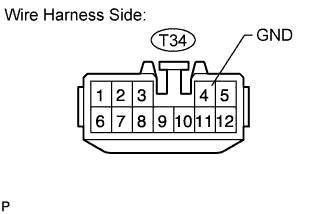 |
Connect the T34 turbo motor driver connector.
Check the turbo motor signal.
Connect an oscilloscope to the terminals of the ECM.
While idling the engine, check the waveform of the ECM.
If the result is not as specified, replace the turbo motor driver.Standard condition ECM Terminal (a) Between E7-10 (VNTO) and E6-7 (E1)
(b) Between E7-17 (VNTI) and E6-7 (E1)Tester Range 5 V/DI.V, 20 msec./DIV. Specified Condition Idling with warm engine - HINT:
- The waveform varies depending on the turbocharger operation.
